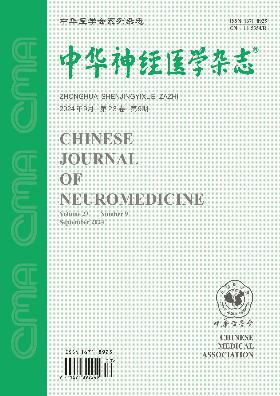Risk analysis of vaccination in children with genetic epilepsy combined with febrile seizures plus
Q4 Medicine
引用次数: 0
Abstract
Objective To assess the risk of vaccination in children with genetic epilepsy combined with febrile seizures plus (GEFS+). Methods Sixty-seven children with GEFS+, admitted to our hospital from May 2016 to May 2019, were enrolled in our study; using targeted second-generation sequencing technology, these patients were divided into positive SCN1A gene mutation group (SCN1A+ group, n=11) and negative SCN1A gene mutation group (SCN1A- group, n=51) after kicking out 5 patients with other gene mutations. The frequencies of convulsion and changes of body temperature after vaccination were analyzed retrospectively in the two groups from birth to age of 7 years. The levels of interleukin (IL)-2, IL-6, IL-10 and tumor necrosis factor (TNF)-α in peripheral blood were measured by flow cytometry in both groups after seizures. Results Children from SCN1A+ group were vaccinated for 34 times, with incidence of post-vaccine convulsion reaching 47% (16/34); children from SCN1A- group were vaccinated for 186 times, with incidence of post-vaccine convulsions reaching 6.45% (12/186); incidence of post-vaccine convulsion was statistically significant between the two groups (P<0.05). The mean body temperature in children from the SCN1A+ group ([38.06±0.57] ℃) during convulsion was significantly lower than that in SCN1A- group ([39.49±0.49] ℃, P<0.05). Expressions of IL-6 and IL-10 in peripheral blood after convulsion in children from SCN1A+ group (96.80±25.05 and 74.90±18.28) were significantly higher than those in SCN1A- group(72.97±4.81 and 43.99±10.63, P<0.05). Conclusion GEFS+ children in the SCN1A+ group are more prone to convulsion after vaccination than those in the SCN1A- group; cytokines may be involved in the development of convulsion. Key words: SCN1A gene; Epilepsy; Convulsion; Vaccine; Heat-sensitivity遗传性癫痫合并热性惊厥患儿接种疫苗的风险分析
目的评价遗传性癫痫合并热性惊厥+ (GEFS+)患儿接种疫苗的风险。方法选取2016年5月至2019年5月在我院住院的67例GEFS+患儿为研究对象;采用靶向二代测序技术,剔除5例其他基因突变患者后,将这些患者分为SCN1A基因突变阳性组(SCN1A+组,n=11)和SCN1A基因突变阴性组(SCN1A-组,n=51)。回顾性分析两组儿童从出生至7岁接种疫苗后惊厥频次及体温变化情况。白介素(IL)的水平2、IL - 6、IL - 10和肿瘤坏死因子(TNF) -α用流式细胞术检测外周血中癫痫发作后两组。结果孩子从SCN1A +组为34次接种,post-vaccine痉挛的发生率达到47% (16/34);SCN1A-组患儿接种186次,疫苗后惊厥发生率为6.45% (12/186);两组疫苗后惊厥发生率比较,差异有统计学意义(P<0.05)。SCN1A+组患儿惊厥时平均体温([38.06±0.57]℃)显著低于SCN1A-组([39.49±0.49]℃,P<0.05)。在外周血il - 6和il - 10的表达惊厥儿童从SCN1A +组(96.80±25.05,74.90±18.28)明显高于SCN1A -组(72.97±4.81,43.99±10.63,P < 0.05)。结论SCN1A+组GEFS+患儿接种后惊厥发生率高于SCN1A-组;细胞因子可能参与抽搐的发生。关键词:SCN1A基因;癫痫;痉挛;疫苗;热敏感性
本文章由计算机程序翻译,如有差异,请以英文原文为准。
求助全文
约1分钟内获得全文
求助全文
来源期刊

中华神经医学杂志
Psychology-Neuropsychology and Physiological Psychology
CiteScore
0.30
自引率
0.00%
发文量
6272
期刊介绍:
 求助内容:
求助内容: 应助结果提醒方式:
应助结果提醒方式:


